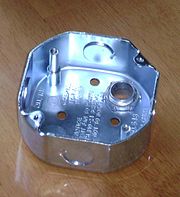
Many residential and commercial electrical systems feature junction boxes. Not to be confused with circuit breakers, they are housing units for electrical connections. Rather than leaving electrical connections exposed, electricians will often place them in a nearby junction box. The junction box will contain the electrical connections so that they are better protected from environmental damage.
Overview of Junction Boxes
A junction box is a protective enclosure for electrical connections. Electrical connections, of course, are points where two or more electrical wires are joined together. They typically involve the use of a connector. Connectors can secure the ends of the electrical wires together so that they form an electrical connection. A junction box is simply a protective housing or enclosure that contains electrical connections and, thus, the connectors used to create them.
The Purpose of Junction Boxes
Junction boxes are designed to protect electrical connections from environmental damage. Electrical wires are typically insulated. They feature a conductive core that’s wrapped in a nonconductive material, such as plastic, rubber or even fluoropolymer. But the insulation is stripped away at the ends where the electrical wires form connections with other wires.
When placed inside of a junction box, electrical connections are protected from environmental damage. They won’t be exposed to leaking water, nor will they be exposed to pests. The junction will provide a safe and secure area for the electrical connections.
While they are used primarily to protect the enclosed electrical connections from environmental damage, junction boxes are also used for safety purposes. Electrical wires carry electricity. Messing with the connections where these wires meet could result in shock. To discourage people from messing with them, electricians may place electrical connections inside of a junction box.
The Different Types of Junction Boxes
All junction boxes consist of hollow boxes. With that said, there are different types of junction types. Some junction boxes are made of plastic. Other junction boxes are made of metal.
Junction boxes can also be categorized according to the way in which they are mounted. There are surface-mounted junction boxes, for instance, that are mounted under floors. And there are wall-mounted junction boxes that are mounted behind walls.
Electrical systems often feature junction boxes. A junction box is an enclosure for electrical connections. It contains the electrical connections that are used to join two or more electrical wires. Rather than leaving the electrical connections exposed to the environment, electricians will often place them inside of a junction box.

